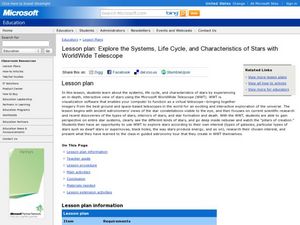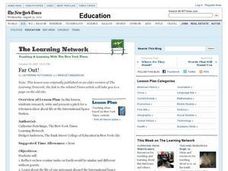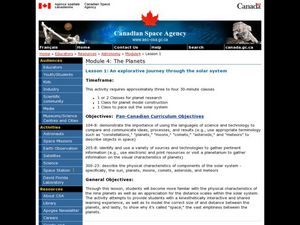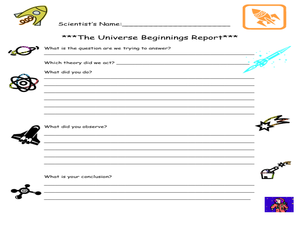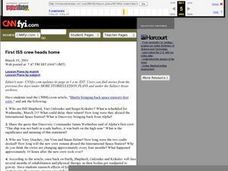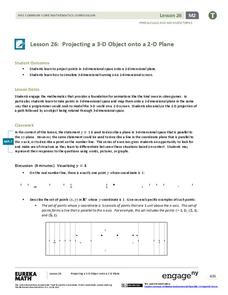Curated OER
Online Exploration: Telescopes From the Ground Up
Students explore a web-based illustrated text and interactive graphics to determine the relationship between the operation of telescopes and light. optics. They work in small groups to become an expert on one of the ten eras of telescope...
Curated OER
Explore the Characteristics of Stars with Microsoft WorldWide Telescope
Students explore the characteristics of stars. In this space science activity, students use the Microsoft WorldWide Telescope program to identify the properties of stars and identify the stars in the galaxy.
Curated OER
A Life Without Flight
Students explore impact of Ohio's aviation pioneers on life in America, discuss what life today would be like without people like the Wright Brothers, John Glenn, and Neil Armstrong, and brainstorm and research list of items that space...
Journey Through the Universe
Is There Anyone Out There?
What is an alien's favorite game? All-star baseball! Scholars start defining living and non-living. Then, they conduct experiments to research if life exists, keeping in mind that life could be in many forms, not just human.
Science 4 Inquiry
Expanding the Universe
When Einstein first heard the theory of the expanding universe, he dismissed it as bad physics. Now scholars learn about the theory and how scientists prove it has merit. Through a hands-on simulation and videos, class members measure...
Curated OER
An Introduction To Pictorial Space
Learners draw a picture of a landscape using techniques that create the illusion of space. They then transform this landscape drawing into a three-dimensional form, which depicts a mood or an emotion.
Curated OER
Milestones in the Space Program
Students brainstorm names of astronauts from NASA space missions. They are explained that the Cold War was not actually a war but pervasive tension that existed between the United States and the Soviet Union for several decades...
Curated OER
Sculptural Space
Students analyze the needs for outdoor sculpture and create their own example. In this sculpture lesson plan, students discuss the sculptural and architectural elements of site-specific sculpture. Students work in teams to select a...
Curated OER
Shape and Space: Symmetry
Students discuss and work with lines of symmetry. In this symmetry lesson plan, students start with a warm up activity on metric conversion. They talk about the definition of symmetry and reflection before completing a worksheet.
Curated OER
In My World
Students identify base words and their inflectional forms. In this base words lesson plan, students learn how adding "ing" can change the meaning of the word, and they fill in a chart with different forms of base words.
Curated OER
Far Out!
Students research and compare/contrast how routine tasks on Earth would be without gravity. They read and discuss the article "The Life Galactic: A Lot of Work, a Little Play, Plenty of E-Mail." In groups they write a pitch for a TV...
Curated OER
Could the Solar System have Ten Planets?
Students react to statements about the solar system, then read a news article about a recently discovered object that could be another planet. In this space science and current events lesson plan, the teacher introduces the lesson plan...
Curated OER
An Explorative Journey Through the Solar System
Students explore space science by creating a planetary model in class. In this solar system lesson plan, students identify the many planets and moons that make up the solar system and decide on one entity in which to research. Students...
Curated OER
Solar Cycle
Students explore the solar cycle through a series of experiments. In this space science lesson, students construct and evaluate solar cycle graphs. They explain how this phenomenon affects the Earth.
Curated OER
Space: The Universe As We Know It!
Learners simulate the Big Bang. In this lesson on the origin of our universe, students role play to show how the Big Bang explosion may have created our universe.
Curated OER
Inventors and Inventions 2:Air and Space
Students fly their own paper airplanes. In this flight lesson plan, students create paper airplanes and see whose plane will fly the farthest. They discuss what factors affect the flight and attempt to create a plane that will go...
Curated OER
Looking and Learning in the Art Museum - Lesson 1
Explore the artistic elements in artworks with an original and reproduction instructional activity. As learners recognize the difference between an original and a reproduction, they discuss the artist elements used in the...
Curated OER
Elements of Art
Third graders discover elements in visual art. In this visual art lesson plan, 3rd graders explore the use of line, shape, and color in visual art. After reviewing works of art, students create unique art pieces. Technology resources...
Curated OER
Space Conservation
Students participate in a class discussion concerning the reasons for space conservation such as no unused land available. Following class discussion, they work in groups to design buildings using allotted amount of area in the most cost...
Curated OER
Brothers in Hope
Students demonstrate their understanding of a book read in class. In this reading comprehension instructional activity, students participate in a process drama led by their teacher in order to demonstrate their understanding of the...
Curated OER
First ISS Crew Heads Home
Students read an article on the first crew of the international space station and answer a series of critical thinking questions.
Curated OER
Toys in Space
Pupilsexplore how gravity affects the operation of toys and simple machines. They watch a video and experiment with simple machines.
NASA
Let's Investigate Mars
Take your science class on a hypothetical field trip to Mars with an engaging astronomy lesson. After first learning about NASA's Mars rover missions, young scientists plan their own scientific investigations of Earth's...
EngageNY
Projecting a 3-D Object onto a 2-D Plane
Teach how graphic designers can use mathematics to represent three-dimensional movement on a two-dimensional television surface. Pupils use matrices, vectors, and transformations to model rotational movement. Their exploration involves...

